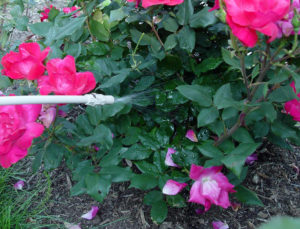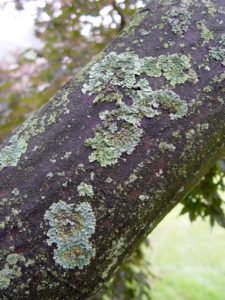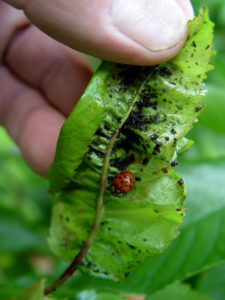To Treat or Not to Treat?
August 4th, 2020
We’ve reached that point in the growing season where much of our gardening time is spent dealing with “issues” that have cropped up with plants.
By now, just about all bugs and diseases have made their annual appearances, not to mention troubles related to animals, weather, and such.
Figuring out what’s gone wrong isn’t always easy, which is why some gardeners – fearing their plants will die if they don’t do something – turn to sprays, fertilizers, and other products in the hope that one of them will help.
Unfortunately, that hail-Mary approach usually doesn’t work.
If you’re not attacking a problem with the right treatment at the right time (assuming treatment was needed in the first place), you’re wasting time and money, needlessly polluting air, water, and sometimes yourself, and maybe even doing something that makes the problem worse.
Now before you say, “Here goes another wacko organic rant,” this is not about the evils of the Ortho aisle.
Sometimes plants really are going to die unless you take action.
Sometimes treatment is justified and effective.
And sometimes a chemical treatment is less harmful to people, plants, and the environment than some of the “natural” products and homemade concoctions that people assume are “safe.”
The missing puzzle piece here is detective work. Before taking any action on a plant problem, I think it’s worth investing in some homework to figure out what’s going wrong.
Often, what looks like a problem isn’t really a problem at all.
Two of the most common examples are when white pines turn yellow in fall (it’s the beginning of a natural, seasonal drop of that plant’s older, inner needles) and the grayish-green scaly growth that people notice growing on their trees (harmless lichens).
Even when an apparent problem really is a problem, how do you know what to do if you don’t know what caused it?
Example: If a plant is browning from a root-rot disease, and you spray it with a bug-killer or douse it with a hefty dose of Miracle-Gro, you’ve at the very least wasted your time and money.
A worried gardener once showed me some leaves from his beloved cut-leaf Japanese maple and asked if I thought the fungicide recommended by the garden center would “cure” it.
The problem, however, wasn’t a disease at all but merely the drying effects of a cold, windy spell the previous week. The fungicide would’ve been a waste.
That kind of misguided treating happens all the time.
We tend to guess, hope for the best, and if one thing doesn’t work, we try another.
The truth is that many of our plant problems aren’t caused by bugs or disease at all but by lousy soil, too much or too little water, over-mulching, clumsy planting practices, adverse weather, and other similar mechanical or “abiotic” mayhem.
We aren’t going to spray our way out of those.
A second truism is that a majority of plant problems are cosmetic or temporary – or both.
Yeah, the roses might look beat up by the Japanese beetles, but the plants will live, new buds will open in September, and some years we’ll have virtually no beetles.
Aphids can fall all over themselves while feasting on your honeysuckle, but ignore them for a few days and the lady beetles usually wipe them out.
Or your lilac might look like it’s on death’s doorstep by fall with whitish mildew all over the leaves, but it comes back to full glory every spring.
The University of Maryland once did an interesting study that found that the bulk of serious landscape damage comes from just three pests – scales, mites, and lace bugs.
Pretty much everything else crawling is good, neutral, or at least not a wanton killer.
What’s more, those three pests tend to go after only about a dozen common plants – fare such as dwarf Alberta spruce (mites), euonymus (scale) and azaleas and pieris (lace bugs).
Diseases are a bit more wide-ranging, but almost all are fairly specific to certain plant families.
To me, the best way to solve plant problems is at plant-buying time – knowing which relative few plants are most likely to get bugs and disease and then scratching them off the list.
That’s much less complicated than treating later.
When treating, you first have to figure out which bug-killer works against which bugs, then you have to know the right time to apply it.
Spray after the bug is gone or at its wrong life stage and the product is ineffective.
Worse yet, you might end up killing the beneficial insects that might be in the process of solving the pest outbreak naturally.
Fungicides are even more complicated.
They’re more targeted and have the Catch-22 dilemma of protecting against disease, not curing it.
In other words, you have to apply most fungicides in advance to keep a disease from causing damage. But if you don’t have the damage yet, how do you know you need the spray?
Read a pesticide label sometime, and you’ll see it’s painstaking to make sure you’re using the right product in the right way. (Read my post on 10 Top Reasons Why You Really Should Read the Pesticide Label.)
I can recommend a few resources to help with this whole sticky issue.
One is Penn State Extension, which has Master Gardeners in every county who are available to answer plant-problem questions and help with diagnoses. Contact information for each county is on the Extension website.
Penn State’s plant pathology lab also offers a free disease-diagnosis service to Pennsylvania residents who send in samples.
The University of Pennsylvania’s Morris Arboretum has a similar free Plant Clinic that offers both plant-ID and diagnosis service.
The University of Maryland has an excellent online Landscape Problem Solver that walks you through a series of choices (all with pictures) to help you zero in on likely plant problems.
The University of Virginia Extension service has a free and excellent online publication that tells you how to zero in on plant problems
The book “What’s Wrong With My Plant?” by Dan Deardorff and Kathryn Wadsworth (Timber Press, 2009, $29.95) is loaded with images and keys to walk you through your plant problems.
And for picking the most trouble-free plants for Pennsylvania landscapes, my website has an archive of more than 300 Plant Profiles, all free to peruse.
My book, “Pennsylvania Getting Started Garden Guide,” features the 170 best landscape plants for Pennsylvania yards, while my “Survivor Plants for Pennsylvania” booklet is 19 pages filled with details on the best plants, best varieties, and their important stats, i.e. size, light needs, bloom times, etc.










